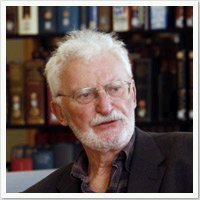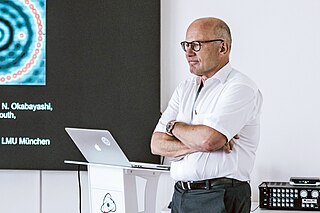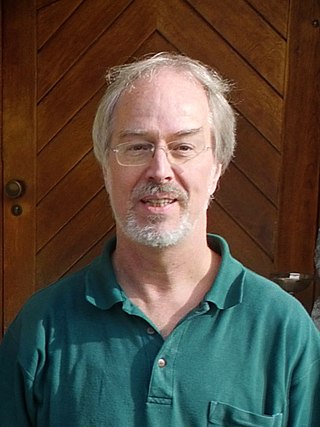
A scanning tunneling microscope (STM) is a type of microscope used for imaging surfaces at the atomic level. Its development in 1981 earned its inventors, Gerd Binnig and Heinrich Rohrer, then at IBM Zürich, the Nobel Prize in Physics in 1986. STM senses the surface by using an extremely sharp conducting tip that can distinguish features smaller than 0.1 nm with a 0.01 nm (10 pm) depth resolution. This means that individual atoms can routinely be imaged and manipulated. Most scanning tunneling microscopes are built for use in ultra-high vacuum at temperatures approaching absolute zero, but variants exist for studies in air, water and other environments, and for temperatures over 1000 °C.

Atomic force microscopy (AFM) or scanning force microscopy (SFM) is a very-high-resolution type of scanning probe microscopy (SPM), with demonstrated resolution on the order of fractions of a nanometer, more than 1000 times better than the optical diffraction limit.
Scanning probe microscopy (SPM) is a branch of microscopy that forms images of surfaces using a physical probe that scans the specimen. SPM was founded in 1981, with the invention of the scanning tunneling microscope, an instrument for imaging surfaces at the atomic level. The first successful scanning tunneling microscope experiment was done by Gerd Binnig and Heinrich Rohrer. The key to their success was using a feedback loop to regulate gap distance between the sample and the probe.
Scanning tunneling spectroscopy (STS), an extension of scanning tunneling microscopy (STM), is used to provide information about the density of electrons in a sample as a function of their energy.

Gerd Binnig is a German physicist. He is most famous for having won the Nobel Prize in Physics jointly with Heinrich Rohrer in 1986 for the invention of the scanning tunneling microscope.

Heinrich Rohrer was a Swiss physicist who shared half of the 1986 Nobel Prize in Physics with Gerd Binnig for the design of the scanning tunneling microscope (STM). The other half of the Prize was awarded to Ernst Ruska. The Heinrich Rohrer Medal is presented triennially by the Surface Science Society of Japan with IBM Research – Zurich, Swiss Embassy in Japan, and Ms. Rohrer in his memory. The medal is not to be confused with the Heinrich Rohrer Award presented at the Nano Seoul 2020 conference.
Spin-polarized scanning tunneling microscopy (SP-STM) is a type of scanning tunneling microscope (STM) that can provide detailed information of magnetic phenomena on the single-atom scale additional to the atomic topography gained with STM. SP-STM opened a novel approach to static and dynamic magnetic processes as precise investigations of domain walls in ferromagnetic and antiferromagnetic systems, as well as thermal and current-induced switching of nanomagnetic particles.

Feature-oriented scanning (FOS) is a method of precision measurement of surface topography with a scanning probe microscope in which surface features (objects) are used as reference points for microscope probe attachment. With FOS method, by passing from one surface feature to another located nearby, the relative distance between the features and the feature neighborhood topographies are measured. This approach allows to scan an intended area of a surface by parts and then reconstruct the whole image from the obtained fragments. Beside the mentioned, it is acceptable to use another name for the method – object-oriented scanning (OOS).
Atomtronics is an emerging type of computing consisting of matter-wave circuits which coherently guide propagating ultra-cold atoms. The systems typically include components analogous to those found in electronic or optical systems, such as beam splitters and transistors. Applications range from studies of fundamental physics to the development of practical devices.
DP is a free software package for physicists implementing ab initio linear-response TDDFT in frequency-reciprocal space and on a plane wave basis set. It allows to calculate both dielectric spectra, such as EELS, IXSS and CIXS, and also optical spectra, e.g. optical absorption, reflectivity, refraction index. The systems range from periodic/crystalline solids, to surfaces, clusters, molecules and atoms made of insulators, semiconductors and metal elements. It implements the RPA, the TDLDA or ALDA plus other non-local approximations, including or neglecting local-field effects. It is distributed under the scientific software open-source academic for free license.
Spinmechatronics is neologism referring to an emerging field of research concerned with the exploitation of spin-dependent phenomena and established spintronic methodologies and technologies in conjunction with electro-mechanical, magno-mechanical, acousto-mechanical and opto-mechanical systems. Most especially, spinmechatronics concerns the integration of micro- and nano- mechatronic systems with spin physics and spintronics.

Donald M. Eigler is an American physicist associated with the IBM Almaden Research Center, who is noted for his achievements in nanotechnology.

Non-contact atomic force microscopy (nc-AFM), also known as dynamic force microscopy (DFM), is a mode of atomic force microscopy, which itself is a type of scanning probe microscopy. In nc-AFM a sharp probe is moved close to the surface under study, the probe is then raster scanned across the surface, the image is then constructed from the force interactions during the scan. The probe is connected to a resonator, usually a silicon cantilever or a quartz crystal resonator. During measurements the sensor is driven so that it oscillates. The force interactions are measured either by measuring the change in amplitude of the oscillation at a constant frequency just off resonance or by measuring the change in resonant frequency directly using a feedback circuit to always drive the sensor on resonance.
Jochen Mannhart is a German physicist.

Franz Josef Gießibl is a German physicist and university professor at the University of Regensburg.

Gerhard Rempe is a German physicist, Director at the Max Planck Institute of Quantum Optics and Honorary Professor at the Technical University of Munich. He has performed pioneering experiments in atomic and molecular physics, quantum optics and quantum information processing.
Jürgen Mlynek is a German physicist and was president of the Helmholtz Association of German Research Centres from 2005 to 2015.
Quantum microscopy allows microscopic properties of matter and quantum particles to be measured and imaged. Various types of microscopy use quantum principles. The first microscope to do so was the scanning tunneling microscope, which paved the way for development of the photoionization microscope and the quantum entanglement microscope.
The operation of a photon scanning tunneling microscope (PSTM) is analogous to the operation of an electron scanning tunneling microscope, with the primary distinction being that PSTM involves tunneling of photons instead of electrons from the sample surface to the probe tip. A beam of light is focused on a prism at an angle greater than the critical angle of the refractive medium in order to induce total internal reflection within the prism. Although the beam of light is not propagated through the surface of the refractive prism under total internal reflection, an evanescent field of light is still present at the surface.
A probe tip is an instrument used in scanning probe microscopes (SPMs) to scan the surface of a sample and make nano-scale images of surfaces and structures. The probe tip is mounted on the end of a cantilever and can be as sharp as a single atom. In microscopy, probe tip geometry and the composition of both the tip and the surface being probed directly affect resolution and imaging quality. Tip size and shape are extremely important in monitoring and detecting interactions between surfaces. SPMs can precisely measure electrostatic forces, magnetic forces, chemical bonding, Van der Waals forces, and capillary forces. SPMs can also reveal the morphology and topography of a surface.












